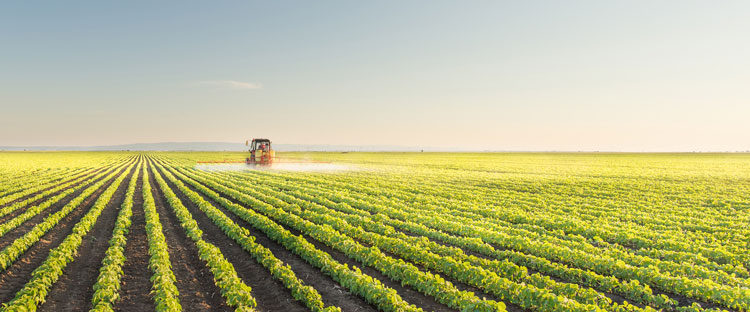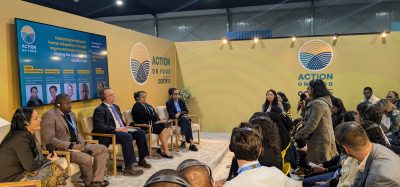Developing crop diversity and genebanks to feed the world
- Like
- Digg
- Del
- Tumblr
- VKontakte
- Buffer
- Love This
- Odnoklassniki
- Meneame
- Blogger
- Amazon
- Yahoo Mail
- Gmail
- AOL
- Newsvine
- HackerNews
- Evernote
- MySpace
- Mail.ru
- Viadeo
- Line
- Comments
- Yummly
- SMS
- Viber
- Telegram
- Subscribe
- Skype
- Facebook Messenger
- Kakao
- LiveJournal
- Yammer
- Edgar
- Fintel
- Mix
- Instapaper
- Copy Link
Posted: 12 October 2018 | New Food | No comments yet
It is undisputed that we need to produce substantially more food in order to feed the world’s ever-growing population. Hannes Dempewolf, Senior Scientist and Head of Global Initiatives at the Crop Trust, speaks to New Food, in particular about the use of genebanks and the collaborative, worldwide efforts needed to feed the world.


What is the Crop Trust, and which genebanks do you help support?
The Crop Trust is the only organisation whose sole mission is to ensure humanity conserves and makes available the world’s crop diversity for future food security. We were founded in Rome, Italy, in 2004 by the Food and Agriculture Organization of the UN (FAO) and Bioversity International on behalf of the CGIAR consortium.
One of the major ways we secure crop diversity is by funding and managing the world’s most important genebanks. We provide long-term grants to 11 CGIAR genebanks holding collections that are critical for global food security and oversee the Genebank Platform. The Platform is a CGIAR initiative supported by the Crop Trust and the CGIAR fund that sustains the core activities of the genebanks. It conserves and makes available crop and tree diversity, ensuring the genebanks meet international standards, improve efficiency and effectiveness.
We also help to support the Svalbard Global Seed Vault – the world’s ‘back-up’ storage facility for seed samples from genebanks around the world in partnership with the Government of Norway, and NordGen, the Nordic Genetic Resource Centre. Established in 2008, the Seed Vault safeguards the biological foundation of our food systems and represents the world’s single largest collection of crop diversity.
How serious is the threat to crop diversity and what are the biggest risks?
The loss of biodiversity is one of today’s most serious environmental concerns. According to some estimates, if current trends persist as many as half of all plant species could face extinction. Among the many threatened species are wild relatives of our crops (CWR – Crop Wild Relatives) – species that could contribute invaluable traits to future crop varieties. It has been estimated that 6% of wild relatives of cereal crops (wheat, maize, rice, sorghum, etc) are under threat, as are 18% of legume species (the wild relatives of beans, peas and lentils) and 13% of species within the botanical family that includes potato, tomato, eggplant, and pepper.
Factors such as changing farming practices, changing consumer preferences and climate change threaten crop diversity. Even the genebanks that conserve this material are sometimes vulnerable, exposed not only to natural catastrophes such as extreme weather events that could physically damage a genebank, but also to avoidable disasters, such as lack of funding or poor management. Something as mundane as a poorly functioning freezer can ruin an entire collection.
It was the recognition of the vulnerability of the world’s genebanks that sparked the idea of establishing the Svalbard Global Seed Vault to serve as a backup storage facility. The purpose of the Vault is to store duplicates (backups) of seed samples from the world’s crop collections. The wise use of crop genetic diversity in plant breeding can contribute significantly to protecting the environment and ensuring food security in the face of growing populations and climate change. However, to achieve this we will need the full array of crop diversity conserved and at our disposal.
If crop diversity continues to be depleted, what impact will this have on the food chain?
Crop diversity is an insurance policy for global food systems. By depleting this resource, we are exposing these systems to higher and higher risks, which could ultimately result in catastrophic failure. Without a concerted and systematic approach for the conservation and use of crop diversity, it is difficult to imagine how we can achieve more resilience and increased productivity in the face of climate change and global population growth.
What is the Crop Wild Relatives programme and how will it help safeguard the future of food?
The Crop Wild Relatives (CWR) program is a 10-year project supported by the government of Norway, with a mission to collect, conserve and initiate the use of wild relatives of crops in pre-breeding programs. The wild relatives of our domesticated crops are one of the greatest sources of untapped diversity, as they contain traits, often not present in our cultivated crops. With agricultural yields predicted to fall significantly due to climate change, we must take critical steps to ensure these wild species are properly safeguarded and utilised.
We specifically focus efforts on areas that are under collected with a high priority on those crops that don’t exist in genebanks at all, or where there are very few varieties available. These crop varieties are sourced from the wild and conserved in genebanks, evaluated for useful traits and prepared for use in pre-breeding programmes, before being made available for use globally by breeders and farmers.
Which crops are most vulnerable to climate change? How is breeding/pre-breeding being used to increase their resilience?
The impact of climate change on the farmer and the crops they grow varies greatly across regions and agricultural systems. It’s often a case of winners and losers, but most crops are affected in some way. Examples of crops that we expect to be most vulnerable include beans in southern and central Africa, maize in eastern and central Africa, potatoes in the Andes, and Arabica coffee across the World.
For all of these crops it will be essential that we explore the diversity within cultivated types, but also the diversity in their wild relatives, so we can breed varieties that are better adapted to future climates. Many cultivated crop varieties have become genetically uniform, and therefore vulnerable. Through systematic crop improvement programmes that work to restore some of the wild qualities more resilient varieties can be developed that can stand up to the challenges of climate change.
Another important way that food production systems can be made more resilient to climate change is through diversification. This means empowering farmers to grow a wider variety of crops and crop varieties to mitigate risk and increase resilience of these systems.
How can the private sector and governments support the protection of crop diversity via genebanks?
To provide some context, the planet needs to produce 50% more food by 2050 to feed a growing population, with climate change challenging the agricultural industry like never before. Adapting our crops to this changing situation has never been more important and yet there has been a general under-investment in crop conservation.
The Crop Trust was established as an essential element of the funding strategy of the 2004 International Treaty on Plant Genetic Resources for Food and Agriculture (ITPGRFA), which establishes an important multi-lateral system for access and the sharing of benefits. At the heart of our organisation is the permanent, self-sustaining Crop Diversity Endowment Fund. Each year, a portion of the fund’s value is used to ensure the conservation and maintenance of crop diversity in genebanks around the globe. Reliable funding is absolutely crucial, as a shortfall in financial resources can lead to the permanent loss of unique crop varieties. That’s why achieving the fund’s target size of $850m is so important.
We strongly believe that a collaborative effort from both governmental and non-governmental sectors in the food and beverage industry and beyond is needed, if we want to ensure the safety of food forever. For example, if your business is dependent on citrus production, it would be beneficial to assess whether farmers will be able to produce a healthy citrus crop for decades to come. This requires investment in the conservation and use of the genetic diversity of citrus to breed new varieties and use existing diversity to combat disease and other challenges the crop is facing. We are eager to pursue innovative ways of financing global common goods, in cooperation with the private sector, public sector, philanthropy, science and civil society.
What does success look like to the Crop Trust?
Our job is done once the world is food secure over the long-term and crop diversity is safeguarded for continued use by breeders and farmers in adapting food systems to future challenges. We believe that national and international genebanks are an essential tool for a food-secure future.
Our mission is to ensure these genebanks are well-functioning institutions that are able to service the needs of farmers and breeders, particularly in areas where climate change and other factors are having the most severe impacts on agriculture. Unfortunately, these impacts are particularly severe for many developing countries, which are a central focus for the Crop Trust. Such genebanks are ideally positioned to drive the broadening of the genetic basis of agricultural production systems by working closely with farmers and their communities, catalysing the transformation of food systems towards greater resilience. We are here to ensure they can play that role, to secure the future of food.
Biography











